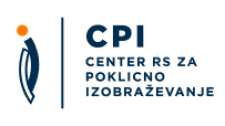Inženir strojništva/inženirka strojništva
Selected qualifications
| Name of qualification | Name of qualification: Inženir strojništva/inženirka strojništvaAdd to comparison |
|---|---|
| Translated title (no legal status) | Translated title: Mechanical engineer |
| Type of qualification | Type of qualification: Short cycle higher vocational diploma |
| Category of qualification | Category of qualification: Educational Qualification |
| Type of education | Type of education: Short cycle higher vocational education |
| Duration |
Duration of education:
2 years
|
| Credits | Credits: 120 credits |
| Admission requirements |
Entry conditions:
|
| ISCED field |
Field:
Engineering, manufacturing and construction
|
| ISCED subfield | subfield: mechanics and metal trades |
| Qualification level |
SQF Level:
SQF 6 |
Students will be able to:
(general competences)
- take into account safety regulations and environmental protection regulations at work;
- develop communication skills in the working environment and beyond;
- use written sources and information technologies;
- adopt a systematic approach to the detection and resolution of problems;
- develop responsibility for professional development;
(specific vocational competences)
- apply the theoretical knowledge they have acquired to act effectively in the working environment;
- use a foreign language for communication and the study of specialist literature;
- use basic knowledge of economics, marketing and project management to run a business;
- apply knowledge of mechanics in determining the dimensions of structural elements;
- analyse the functioning of electrical circuits and eliminate simple faults, taking the appropriate protective measures;
- draw up a technological manufacturing process;
- select, determine and evaluate time and manufacturing costs and select tools;
- select appropriate materials, appropriate heat treatment and corrosion protection on the basis of requirements and demonstrate familiarity with the impact of materials on the environment;
- plan products taking into account relevant technical legislation;
- draw up technical documentation in all phases of the creation of a product;
- use a computer to prepare and monitor manufacturing cost plans and schedules;
- apply quality management and quality assurance methods in the production process;
- plan simple energy systems and demonstrate familiarity with the functioning of more complex energy systems;
- ensure the economical and environmentally acceptable consumption of energy;
- recognise opportunities to introduce automation and conduct projects in the field of the automation of manufacturing processes;
- autonomously plan the automation of simple manufacturing processes and participate in the planning and introduction of automation of complex manufacturing processes;
- plan, organise and lead preventive maintenance work on machines, devices and energy systems in the manufacturing process;
- analyse the impact of maintenance on a company's costs;
- plan and organise work and lead production;
- plan costs and investment in manufacturing processes;
- train for the construction process of designing tools on the basis of a client's requirements, including selection and definition of the standard parts of a tool;
- demonstrate knowledge of the economic and technological characteristics of a tool.
Students' knowledge is assessed by means of practical exercises and seminar papers, and also via products, projects, performances, services, etc. and by examinations. Examination performance is scored as follows: 10 (excellent); 9 (very good: above-average knowledge but with some mistakes); 8 (very good: solid results); 7 (good); 6 (adequate: knowledge satisfies minimum criteria); 5–1 (inadequate). In order to pass an examination, a candidate must achieve a grade between adequate (6) and excellent (10).
Students may progress to the second year if they have successfully completed first-year modules, subjects and practical training (including practical classes, seminar papers, projects, examinations, etc.) totalling at least 45 credits, where all practical classes and practical training course units must be completed in full.
Inženir strojništva/inženirka strojništva
SQF 6
EQF 5
The Career path tab shows the possible career path within the selected qualification area, which is not the only one and is not mandatory. The actual transition between qualifications, which is determined by law, is defined in the Transition tab.
Diplomirani inženir dizajn inženiringa (un)/diplomirana inženirka dizajn inženiringa (un)
Diplomirani inženir materialov (un)/diplomirana inženirka materialov (un)
Diplomirani inženir strojništva (un)/diplomirana inženirka strojništva (un)
Diplomirani inženir strojništva (un)/diplomirana inženirka strojništva (un)
Diplomirani inženir strojništva (vs)/diplomirana inženirka strojništva (vs)
Diplomirani inženir strojništva (vs)/diplomirana inženirka strojništva (vs)
Diplomirani inženir tehnolog (vs)/diplomirana inženirka tehnologinja (vs)
SQF 7 / EQF 6
SQF 10 / EQF 8
First-cycle study programmes (SQF, level 7)
In order to complete the programme, students must complete all compulsory modules and subjects, for a total of 79 credits: Communications (24 credits), Mechanics 1 (5 credits), Basics (21 credits); Operations and processes (13 credits), Technologies (16 credits); one elective module consisting of 9 credits: Automation (9 credits), Energy (9 credits); one elective module consisting of 17 credits: Toolmaking (17 credits), Manufacturing (17 credits), Maintenance (17 credits); one of the following elective subjects consisting of 5 credits: Electrical engineering (5 credits), Machine elements (5 credits), Computer modelling (5 credits) or a subject from other elective modules (5 credits); a freely elective subject (5 credits) and a bachelor's thesis (5 credits)
Higher vocational colleges
URL
Awarding body URL:Upcoming event
International Conference: 10 years of Slovenian Qualifications Framework
International Conference: 10 years of Slovenian Qualifications Framework Brdo Congress Centre, Predoslje 39, 4000...
© Center RS za poklicno izobraževanje, 2018. All rights reserved
Sitemap General legal notice Cookie Policy Production: ENKI






